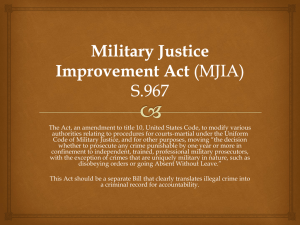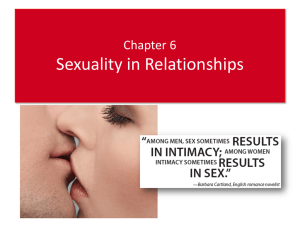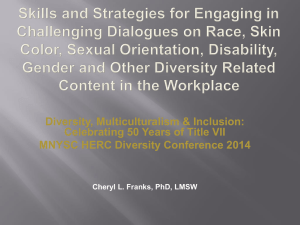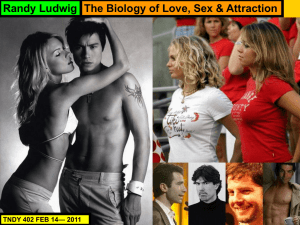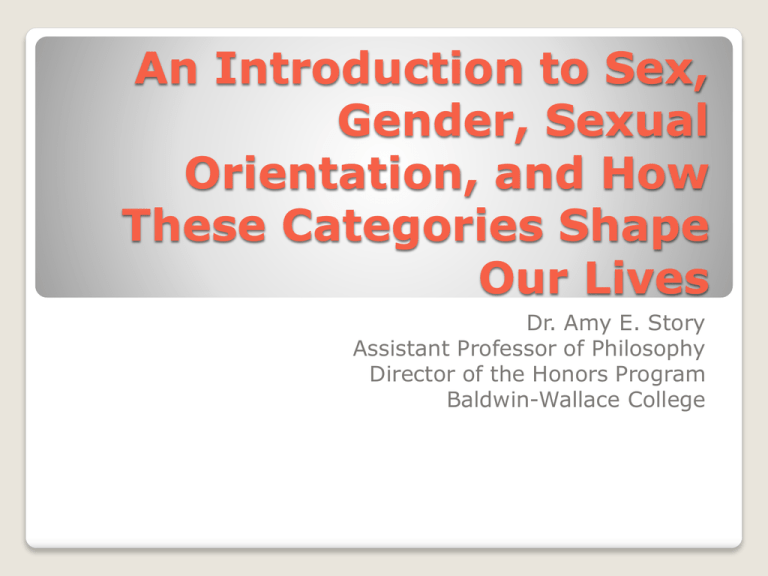
An Introduction to Sex,
Gender, Sexual
Orientation, and How
These Categories Shape
Our Lives
Dr. Amy E. Story
Assistant Professor of Philosophy
Director of the Honors Program
Baldwin-Wallace College
What are the
first things we
notice about
people when
we initially
encounter
them?
Why does it tend to
bother us when we can’t
immediately tell
someone’s gender (…or
are we trying to
determine their sex?)?
Gender as something that we “do” or
“perform”
◦ Gender identity vs gender expression
VS
Sex as a group of biological components
that tend to work together (hormones,
chromosomes, sex organs)
Gender as a “script” for life
Biology is NOT destiny
Gender does not simply express an
underlying biological foundation
Evolutionary pressures related to
reproduction probably DO influence some
general gendered tendencies
The relationship between sex and
gender is complex
Masculinity
What behaviors,
skills, and attitudes
do we associate with
masculinity in our
culture?
Femininity
What behaviors,
skills, and attitudes
do we associate with
femininity in our
culture?
What are the “scripts”
for gender?
Where do these gender “scripts”
come from?
“It is the best for all tame animals to be
ruled by human beings. For this is how
they are kept alive. In the same way, the
relationship between the male and the
female is by nature such that the male is
higher, the female lower, that the male
rules and the female is ruled.”
Politica, ed. Loeb Classical Library, 1254 b 10-14.
Aristotle (384-322 BCE)
“Laborious learning or painful pondering, even if a
woman should greatly succeed in it, destroys the
merits that are proper to her sex, and because of
their rarity they can make of her an object of
cold admiration; but at the same time they will
weaken the charms with which she exercises her
great power over the other sex. […] The beautiful
understanding selects for its objects everything
closely related to the finer feeling, and
relinquishes to the diligent, fundamental, and
deep understanding abstract speculations or
branches of knowledge useful but dry.”
Of the Distinction of the Beautiful and Sublime in the Interrelations of
the Two Sexes, 1764
Immanuel Kant (1724-1804)
“Hence it will be found that the fundamental
fault of the female character is that it has no
sense of justice. This is mainly due to the
fact, already mentioned, that women are
defective in the powers of reasoning and
deliberation; but it is also traceable to the
position which Nature has assigned to them
as the weaker sex. They are dependent, not
upon strength, but upon craft; and hence
their instinctive capacity for cunning, and
their ineradicable tendency to say what is not
true.”
“On Women”, 1851
Arthur Schopenhauer (1788-1860)
“I know this is painful for the ladies to hear,
but if you get married, you have accepted the
headship of a man, your husband. Christ is
the head of the household and the husband
is the head of the wife, and that's the way it
is, period." (700 Club, 1992)
"(T)he feminist agenda is not about equal
rights for women. It is about a socialist, antifamily political movement that encourages
women to leave their husbands, kill their
children, practice witchcraft, destroy
capitalism and become lesbians.”
(Fundraising letter, 1992)
Pat Robertson (1930-present)
The ideas that we have inherited from
history about gender still play important
roles in our lives
In order to really understand how gender
and also sexual orientation work in our
society, we have to understand something
about gender oppression
Understanding Gender =
Understanding Gender Oppression
The pervasive and systematic
mistreatment of people on the basis of
their membership, or perceived
membership, in certain groups.
Helpful concepts from Marilyn Frye,
“Oppression,” 1983
Birdcage
Double-bind
Oppression
In small groups, come
up with a list of a few
“wires” that women
face on a regular basis.
What might be an example of
a “wire” in the way of people in
other oppressed groups, for
instance:
a. Someone living in poverty?
b. An illegal immigrant living in
the US?
Birdcage
Like having the wind
at your
back…
The Other Side of Oppression =
Unearned Privilege
Peggy McIntosh:
“Unpacking the Invisible Knapsack of
White Privilege” 1991
White
privilege is
only one kind
of privilege,
but it serves
here as a
good example
for what it
means to
receive
unearned
privileges that
others are
denied.
I can, if I wish, arrange to be in the
company of people of my race most of
the time.
I can go shopping alone most of the
time, pretty well assured that I will not
be followed or harassed.
I can turn on the television or open to
the front page of the paper and see
people of my race widely represented.
When I am told about our national
heritage or about “civilization,” I am
shown that people of my color made it
what it is.
White Privilege
In small groups, come up with one
statement that completes each of the
following sentences (it doesn’t matter if
they apply to you):
◦ Because I am able-bodied, I can…
◦ Because I am heterosexual, I can…
◦ Because I am male, I can…
◦ Because I live in a wealthy nation, I
can…
Unearned Privilege
Gender is generally understood as a way of
identifying how one feels internally and behaves
externally on a continuum of masculine and
feminine.
Masculine-------------Androgynous---------------Feminine
Historically, women and the feminine ways of
being associated with women, have been
undervalued compared to men and masculine
ways of being. Women have been oppressed and
men have been privileged by their gender.
Summing up Gender…
The basics:
◦ Describes an individual’s emotional and sexual
attraction to others of the same or different sex
(i.e., homosexual, heterosexual, bisexual)
◦ Is not necessarily based on one’s biological sex
OR one’s gender identity or gender expression
Sexual Orientation
If gender has historically been understood
in a binary way and as an expression of
one’s “natural” biological sex,
heterosexuality has been understood
along side gender as the “natural” form of
sexual orientation
Reactions to non-hetersexual orientations
are grounded in the history of genderbased oppression (ie, sexism)
Connecting Gender and Sexual
Orientation
How are gay men, lesbians, and bisexual
people breaking the gender “rules”?
Why is it more acceptable for women to
“experiment” sexually with other women than
it is for men to do so with other men?
Homophobia and sexual violence
Suzanne Pharr, Homophobia: a Weapon of Sexism, 1997
Homophobia Is Rooted in Sexism
Homophobia is Rooted in Sexism:
◦ Sexual Identity and Sexual Position
Penetrator vs penetrated
Sexual Identity and Class
Study in Puerto Rico
(Sager, Schlimmer, and Hellmann, 2001)
◦ Socioeconomic status and sexual identity
among men who have sex with men
Low SES = straight identity
Mid SES = bisexual identity
High SES = gay identity
Identity Formation and Power:
Sexual Identity in Latin America
People throughout time have sought ways
of identifying their gendered and sexual
lives that break out of the simple binary
of male/female and masculine/feminine.
It is only relatively recently, though, that
we have started to develop a vocabulary
and the social awareness needed to think
and talk beyond simple binary categories.
Our World Today: Rethinking Sex,
Gender, and Sexual Orientations
An umbrella term for LGBT communities
◦ Gender-queer
Reclaimed from being a slur beginning in the 1980’s
Regional variation in the use of this term
◦ Applications beyond LGBT communities
New Gender Categories: Queer
Bigender: To identify as both genders and/or to have a
tendency to move between masculine and feminine
gender-typed behavior depending on context, expressing a
distinctly male persona and a distinctly female persona,
two separate genders in one body.
Gender Bender: An individual who “bends,” changes,
mixes, or combines society’s gender conventions by
expressing elements of masculinity and femininity together
Androgynous: A person who may appear as and exhibit
traits traditionally associated as both male and female, or
as neither male nor female, or as in between male and
female.
Pangender: A person whose gender identity is comprised
of many gender expressions.
Examples of New Gender
Categories (Sexual Fluidity Project)
Androsexual: Anyone who has sexual
feelings towards a man.
Gynosexual: Anyone who has sexual
feelings towards a woman.
Androgynosexual: A person who has sexual
attraction towards both men and women,
particularly those with an androgynous
appearance.
Polyamorous: Refers to having honest,
usually non-possessive, relationships with
multiple partners
Examples of New Sexual
Orientation Categories
(Sexual Fluidity Project)
Labels matter
Allow for selfnaming
New Vocabulary, New Possibilities








